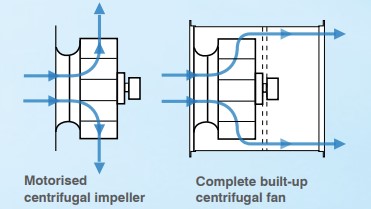To ensure a ventilation system functions in the built environment as it was intended in the design stages, it is crucial to know that the fan’s actual performance matches the catalogue data published by the manufacturer. The only true way to measure the performance of a fan is by using a specially designed air flow test rig which is compliant to an international standard, such as ISO5801:2007, industrial fans - performance testing using standardised airways.
Australian fan manufacturers purchase their motorised external-rotor centrifugal impellers from the major suppliers in Europe and increasingly cheaper product from Asia. These suppliers only test the fan in the very basic configuration where the setup consists of a motorised impeller, inlet cone and a simple motor mount. This allows the fan to perform without restrictions which produces the optimum values for air flow, noise and efficiency.
However, when this motorised impeller is fitted into a housing, which could consist of a cowl, casing or plenum, the fan’s performance characteristics change significantly. It is important to remember that motorised impellers will be used in many fan types, including roof mounted in downflow and vertical discharge configurations, wall mounted and duct mounted.
These components all have an effect on the way the air leaves the impeller and the overall performance of the fan. For example with an in-line duct mounted centrifugal fan, the air is forced to change direction once it hits the wall of the casing. This together with the air flow losses associated with surface friction, dramatically affects the pressure development capabilities of the fan. In addition to these reductions, the noise level increases and the overall efficiency of the fan decreases. Furthermore if these components are poorly designed, the performance loss is amplified.

It has been observed that “motorised impeller only” performance data is being published by several local fan manufacturers as the performance data for their complete built-up centrifugal fan. This method is not only incorrect, it is misleading as the complete built fan will never perform to this level. As a result numerous sites have required larger fans to be installed, as the original selected fans did not perform as per the catalogued performance data. These reworks are an extremely costly exercise as access to the fan can be difficult and can cause disruptive project delays.
Fantech’s in-house capability allows it to perform air flow testing using their purpose-built air flow rigs which have been specifically designed to test to ISO5801:2007. In addition, Fantech’s sister company Elta Fans UK, has the capability to perform noise testing to BS848:Part 2 1985.
Fantech recently undertook testing to determine the actual differences in performance between a motorised centrifugal impeller only assembly and a built-up centrifugal fan in a housing. At a given duty point the results are as follows:
- 15% reduction in air flow
- 37% reduction in pressure development
- 14% reduction in efficiency
- 8% reduction in peak efficiency
- 1.2dB noise increase
It should also be noted that the tests performed by the motorised impeller manufacturers are completed using their purposely-designed inlet cones and are set to have an ideal overlap between impeller and inlet cone. To reduce production costs many of the local fan manufacturers use their own inlet cones which suit a variety of their fan ranges. These inlet cones often do not follow the supplier’s overlap recommendations, thereby further reducing performance.
When ordering fans it is important to question whether the performance data comes from a complete built-up centrifugal fan with housing, brackets etc, or is it from the motorised impeller only. The majority of imported motorised centrifugal impellers are sourced from Germany and these are tested to a German DIN standard such as DIN24163 so if the data of a locally assembled complete built-up fan is published to a German DIN standard rather than an ISO standard you have to question how accurate the assembled fan performance data is.
Every fan range engineered and sold by Fantech is thoroughly tested as a fully assembled fan during the development process to determine its true performance. The fan tested is exactly the same as the unit purchased and installed by the contractor. As a result Fantech has comprehensive data on each fan model and therefore has the ability to publish accurate and reputable technical catalogue data. This information is beneficial to the end user as they can be confident that the fan will perform as intended.
